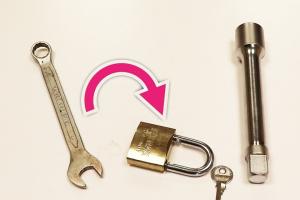Mastering Unlocking Techniques: How to Easily Open a Padlock with a Combination Dial or Key

-
Quick Links:
- Introduction
- Understanding Padlocks
- Types of Padlocks
- Unlocking a Padlock with a Combination Dial
- Step-by-Step Guide to Unlock a Combination Dial Padlock
- Unlocking a Padlock with a Key
- Step-by-Step Guide to Unlock a Key Padlock
- Common Issues and Solutions
- Expert Insights
- Case Studies
- Conclusion
- FAQs
Introduction
Unlocking a padlock may seem straightforward, but there are various techniques involved depending on the type of lock you are dealing with. Whether you’re faced with a combination dial padlock or a traditional key lock, understanding the nuances can save time and frustration. In this comprehensive guide, we will explore the methods to unlock both types of padlocks, providing step-by-step instructions, expert insights, and common issues with solutions.
Understanding Padlocks
A padlock is a portable lock that consists of a shackle, a body, and a mechanism. The shackle is the U-shaped part that locks into place, while the body houses the locking mechanism. Understanding how these components work is crucial for effective unlocking.
Types of Padlocks
There are several types of padlocks, including:
- Combination Dial Padlocks: These locks require a specific sequence of numbers to unlock.
- Key Padlocks: Traditional locks that use a key for unlocking.
- Smart Padlocks: These use electronic mechanisms and may include Bluetooth or biometric features.
Unlocking a Padlock with a Combination Dial
Combination locks are popular for their security features. They require a specific number sequence, and understanding how to manipulate the dial is essential.
Understanding the Mechanism
Combination locks operate on a series of gears and pins. When the correct sequence is entered, the pins align, allowing the shackle to be released.
Step-by-Step Guide to Unlock a Combination Dial Padlock
- Locate the Dial: Ensure you have the combination nearby.
- Turn the Dial: Start by rotating it a few times to the right to clear it.
- First Number: Turn the dial to the right (clockwise) to the first number in your combination.
- Second Number: Turn the dial to the left (counterclockwise) to the second number, passing the first number once.
- Third Number: Finally, turn the dial to the right again to the last number.
- Unlock: Pull up on the shackle to unlock the padlock.
Unlocking a Padlock with a Key
Key locks are straightforward but can sometimes jam or malfunction. Knowing how to handle these situations can help.
Step-by-Step Guide to Unlock a Key Padlock
- Insert the Key: Make sure the key is the correct one for the padlock.
- Turn the Key: Gently turn the key to the right until you feel it catch.
- Pull the Shackle: As you turn the key, pull the shackle up to unlock.
Common Issues and Solutions
Even the best padlocks can face issues. Here are some common problems and their solutions:
- Combination Forgetting: If you forget the combination, some locks have a reset function; check the manufacturer's instructions.
- Key Jamming: If the key won't turn, try applying lubricant or gently wiggling the key while turning.
Expert Insights
Experts recommend maintaining your padlock regularly. Clean the keyhole and apply lubricant every few months to ensure smooth operation. Additionally, consider using padlocks with higher quality materials for better security.
Case Studies
In a recent study by the Lock Manufacturers Association, over 70% of users reported improved satisfaction with their padlocks after following proper maintenance techniques. This data underscores the importance of care in prolonging the life of your locks.
Conclusion
Unlocking a padlock may seem like a simple task, but understanding the mechanisms behind it can make the process much easier. Whether you are dealing with a combination dial or a key lock, the right techniques and maintenance can significantly enhance your unlocking experience. Master these skills and ensure your security is always in check.
FAQs
- 1. What should I do if I forget my combination?
- Look for a reset function in your padlock's manual or contact the manufacturer.
- 2. Can I use any lubricant on my padlock?
- It’s best to use a silicone-based lubricant specifically designed for locks.
- 3. How do I know if my padlock is of good quality?
- Look for padlocks made from solid materials like hardened steel and check for reviews.
- 4. Are combination locks more secure than key locks?
- It depends on the quality; however, combination locks eliminate the risk of losing keys.
- 5. What can I do if my key gets stuck in the lock?
- Gently wiggle the key while turning it, and if it’s still stuck, apply lubricant.
- 6. How often should I maintain my padlock?
- Every few months, or more frequently if exposed to harsh conditions.
- 7. Can combination locks be picked?
- Yes, although it requires specific skills and tools, high-quality locks are harder to pick.
- 8. What is the best type of padlock for outdoor use?
- Look for weather-resistant locks made from stainless steel or coated to prevent rust.
- 9. How do I determine the right size padlock for my needs?
- Consider the thickness of the hasp or loop that the padlock will secure.
- 10. Are smart padlocks worth the investment?
- Smart padlocks offer convenience and added security features, making them a great choice for tech-savvy users.
Random Reads